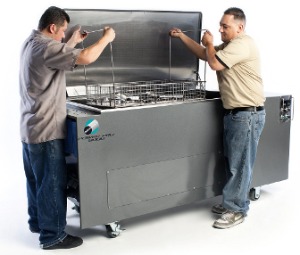More on Selecting Ultrasonic Cleaning Solutions

Solution maintenance is a wise step for high-volume ultrasonic cleaners
As we suggested in our blog post How to Select Ultrasonic Cleaner Solutions* cleaning solution chemistry has an important bearing on the success of operating an ultrasonic cleaner. Here we will look at some other considerations to keep in mind.
For example, the choice of a cleaning chemistry depends not only on the surface material and contamination, but also on the use and level of cleanliness required after cleaning. Here are but two of many examples we could share:
For precision cleaning prior to coating operations you need a cleaner that easily rinses residue-free. This helps ensure that coatings such as powder, anodizing, chromium plating or paint will fully adhere to the surface. For applications such as these we strongly suggest EC 260 d&s neutral foam-inhibited concentrate.
There are less-demanding levels of cleanliness for other applications. If your shop cleans, repairs or reconditions used equipment made of materials such as plastic, steel, aluminum, glass, stainless or copper, a single alkaline cleaning solution such as elma tec clean A4 is great for removing dirt, grease and oils. These contaminants are not effectively removed by neutral ultrasonic cleaning solutions. As another example mildly alkaline elma tech clean A1 is widely used for cleaning plastic cell phone and PDA housings. Link to the product description.
Ultrasonic Cleaning Solution Maintenance
Contaminants removed during ultrasonic cleaning have to go somewhere and that “somewhere” is in the cleaning solution itself. This is why solutions must be drained and replaced (and the tank cleaned) on a regular basis. For some operations replacement time is signaled by visibly dirty solutions and longer cleaning processes. In others, notably the removal of grease and oils, it is evidenced by oils rising and floating on the surface. Not as evident are contaminants that settle to the bottom of the tank.
Cleaning solutions can be specified based on how you deal with grease and oils. In these instances they are classified as emulsifying and demulsifying cleaners. In the former instance oils remain suspended in the cleaning solution and in the latter they rise to the surface and can be skimmed off.
For low-volume, low throughput operations an emulsifying cleaner such as elma clean 210 is more convenient. The downside is that it requires close observation of the solution itself so that it is drained and replaced before accumulated contaminants inhibit ultrasonic cleaning efficiency. And since contaminants remain in suspension they will adhere to the finished product. This may call for a post-cleaning rinse.
We recommend a demulsifying cleaner such as Elma tech clean A4 for high volume, high throughput operations. The oil can be skimmed off and the lifetime of the solution can be extended. Larger industrial-sized ultrasonic cleaners such as the Shiraclean line available available from Tovatech are available with a skimming ledge that channels the contaminants into a holding tank for proper disposal. If an emulsifying cleaning solution is used in industrial-sized units an option is to connect an oil separator to the equipment. The solution is circulated through the separator where suspended oil is removed and the treated solution returned.
Filters are available to extend ultrasonic cleaning solution life. These can quickly pay for themselves when used on large capacity units. The best are dual-filter systems that first remove particles that cause wear on the pump while the second removes smaller contaminants. Filter replacement time is signaled by a pressure gauge.
Regardless of how you extend the life of your ultrasonic cleaning solution you must include tank cleaning as part of the maintenance procedure. Follow the manufacturer’s recommendations and in no case use an abrasive when removing sediments on the bottom of the tank.
In summary, today’s biodegradable ultrasonic cleaning solution concentrates are available in many different formulations, each designed for specific cleaning requirements. Cleaning solution selection is part of the equation but you must also factor in cleaning solution – and tank – maintenance. The ultrasonic cleaning professionals at Tovatech are ready to help you make the right decisions for your cleaning requirements.
*See How to Select Ultrasonic Cleaner Solutions
Please share challenges you have faced and solved by using a specific ultrasonic cleaning solution formulation.
